NEC Cortex-A9 SoC takes on Tegra in tablet market
Feb 12, 2010 — by Eric Brown — from the LinuxDevices Archive — 13 viewsNEC Electronics announced an ARM Cortex-A9 version of its Linux-ready EMMA Mobile series of multimedia system-on-chips, and it's also shipping a Linux/Android hardware/software kit for its earlier EMMA Mobile 1. The EMMA Mobile/EV SoCs can play 1080p video, and come in single-core (EV1) and dual-core (EV2) versions, the latter equipped with 2D/3D graphics acceleration.
Targeting battery-powered portable devices ranging from portable multimedia players (PMPs) to mobile tablets, the EMMA Mobile/EV1 and EMMA Mobile/EV2 system-on-chips (SoCs) boast power consumption thirty percent lower than the earlier EMMA Mobile 1, claims NEC. (See farther below for more background on the EMMA Mobile 1 and its new HDK and SDK.)
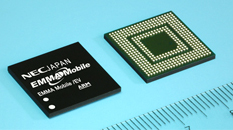
EMMA Mobile/EV1 and EMMA Mobile/EV2
The single (EV1) or dual (EV2) cores, which include ARM's Neon multimedia instruction set, are said to be paired with a 1080p HD-ready audio-visual (A/V) engine capable of decoding numerous digital video and audio formats (see spec table below). In addition the EV2 model offers Imagination Technology's SGX530 2D/3D graphics engine, says NEC.
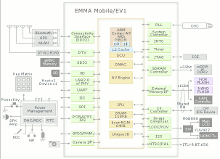
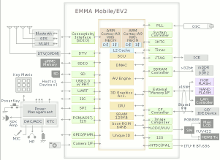
Block diagrams for the EV1 (left) and dual-core EV2 (right)
(Click on either to enlarge)
NEC did not list operating system support for the SoCs. For many years, however, EMMA processors, including the company's recent EMMA Mobile 1, have supported Linux (see farther below).
Specifications listed for the EMMA Mobile/EV SoCs include:
- CPU — ARM Cortex-A9 (533MHz FSB) with Neon, 32KB I/D cache, and 256KB L2 cache (2 x cores for EV2)
- AV engine:
- H.264 decode: BP/MP/HP Full HD (1920 x 1080)
- MPEG2 decode: MP Full HD
- MPEG4 decode: SP/ASP Full HD
- VC-1 decode: SP/MP/AP Full HD
- MP3, AACHE-AAC,WMA decode
- AC-3 decode Dolby digital 5.1ch
- Graphics/display:
- Image resize
- YUV/RGB image rotation
- LCD output image composition
- 2D/3D graphics engine (EV2 only) with Imagination Technology's SGX530 2D/3D core (4.7Mpolgon/sec 500Mpixel/sec)
- Flash — Supports NOR, NAND, and eMMC
- I/O interfaces:
- LCD (RGB565/666/888)
- NTSC/PAL (ITU-R BT.656)
- Serial:
- UART (4-port)
- IIC (2-port)
- Multi-function serial (6-port), selectable to SPI or Audio
- USB 2.0 Host/Device
- 1-ch SD; 3-ch SDIO
- Camera (8-bit parallel)
- DTV (TS Serial)
- GPIO
- PWM
EMMA Mobile 1 SDK and HDK
In September, NEC Electronics announced it was sampling a software development kit (SDK) for portable multimedia players and mobile televisions, based on its ARM11-based EMMA Mobile 1 SoC. The promised hardware development kit (HDK) is now ready, along with extensions to the Linux SDK that support Android, says NEC. The SDK combines Wind River Linux 3.0 with NEC's device drivers and media components.
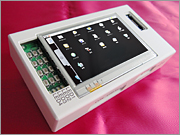
EMMA Mobile 1 HDK
One of a long line of EMMA SoCs aimed at consumer electronics, the EMMA Mobile 1 was announced in November 2008, and began shipping in volume last summer. The Mobile 1 is based on an ARM11 core, unlike NEC's recently announced, dual-core EMMA3SL/P SoC for IPTVs, which is MIPS-based.
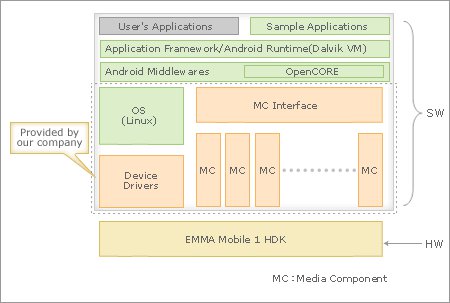
EMMA Mobile 1 SDK Standard Edition, Android version architecture
(Linux version is identical except for omission of second and third layers from top)
The new wrinkle on the "EMMA Mobile 1 SDK Standard Edition" is the addition of an Android version. The Linux version uses Linux 2.6.27, whereas the Android version builds upon a Linux 2.6.29 kernel with the Android 1.6 ("Donut) SDK. Both versions offer on-chip/on-board device drivers with source code, as well as a media components interface based on NEC's OViA Media Framework (OMF), which it says is equivalent to OpenMAX IL 1.1.2.

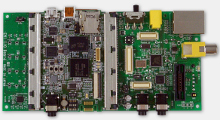
EMMA Mobile 1 HDK and HDK board with attached CPU module
(Click on either to enlarge)
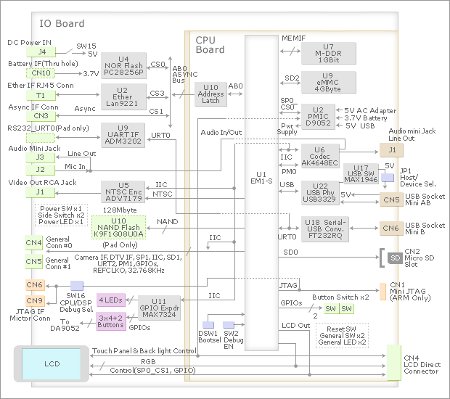
EMMA Mobile 1 HDK block diagram
(Click to enlarge)
- LCD (WVGA with touchscreen)
- Audio (LSI AK4648 codec)
- 1 x Mic-in x 1
- 2 x Line-out
- USB miniAB (Host/Device)
- TV out (NTSC/PAL)
- Ethernet (RJ45)
- MicroSD card slot
- Debug (ARM/DSP)
- Console (with serial-USB converter)
- General-purpose connector
The HDK supports 100 to 240VAC power, as well as li-ion batteries (USB power support is planned), and is further equipped with various keypads, switches, and LEDs. The HDK is said to ship with circuit diagrams and other design documentation. Eventually, NEC plans to release the CPU board as a standalone module.
Other Cortex-A9 SoCs include the Texas Instruments OMAP4 series of processors, and Nvidia's Tegra 250, which is appearing in a number of new tablet designs. Additional semiconductor manufacturers preparing Cortex-A9 SoCs include ST-Ericsson and NXP.
Availability
Samples of the EMMA Mobile/EV1 and EV2 SoCs are scheduled to be available in July at $50 per unit, says NEC. Mass production is scheduled for December, and is expected to reach one million units per month by 2011.
More information about the EMMA Mobile/EV SoCs can be found here, and more on the Emma Mobile 1 and new HDK/SDK (which appears to be shipping) may be found here.
NEC Electronics plans to exhibit the EMMA Mobile EV SoCs in NEC's booth (Hall 8, Stand 8A125) next week at the Mobile World Congress in Barcelona.
This article was originally published on LinuxDevices.com and has been donated to the open source community by QuinStreet Inc. Please visit LinuxToday.com for up-to-date news and articles about Linux and open source.